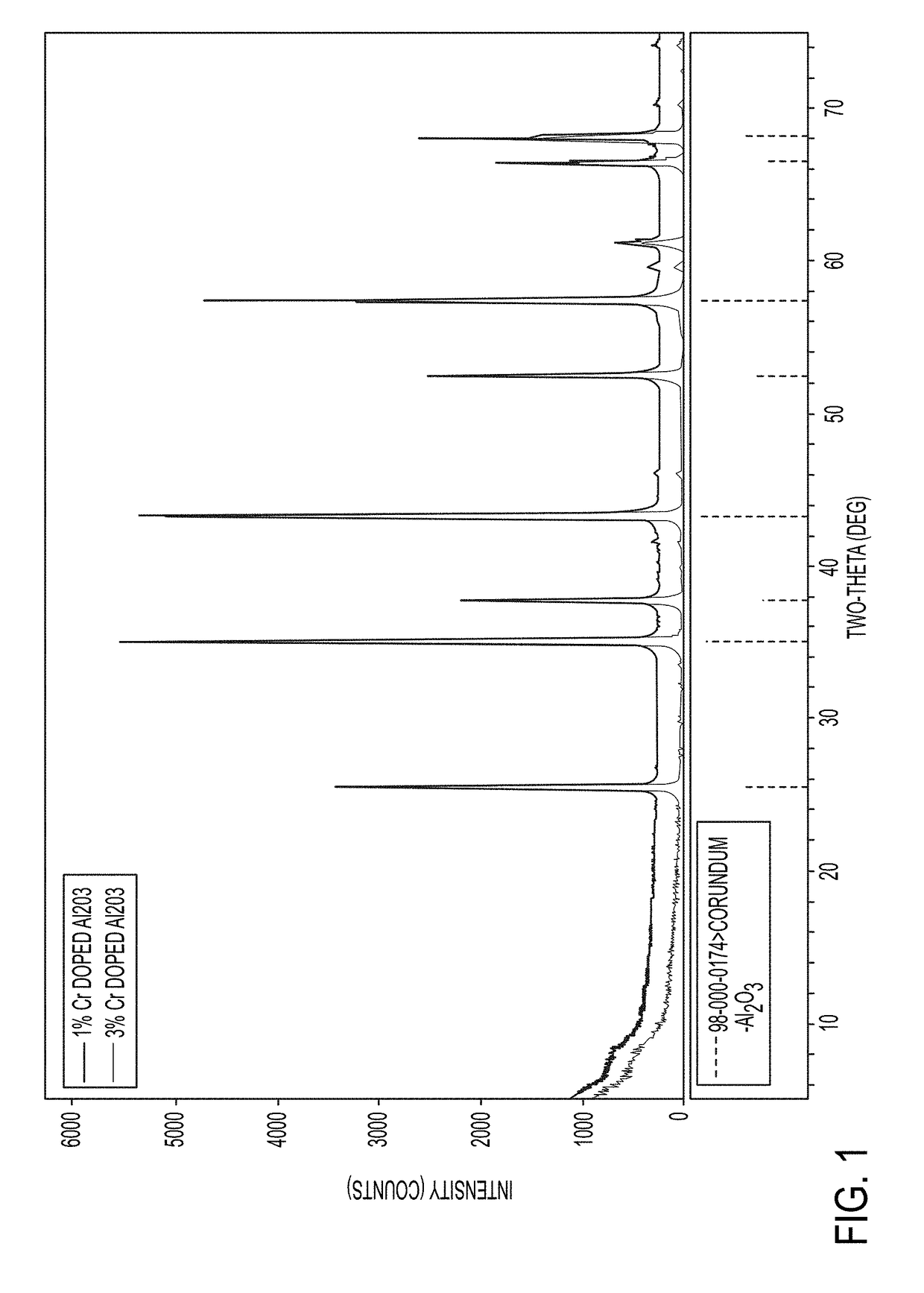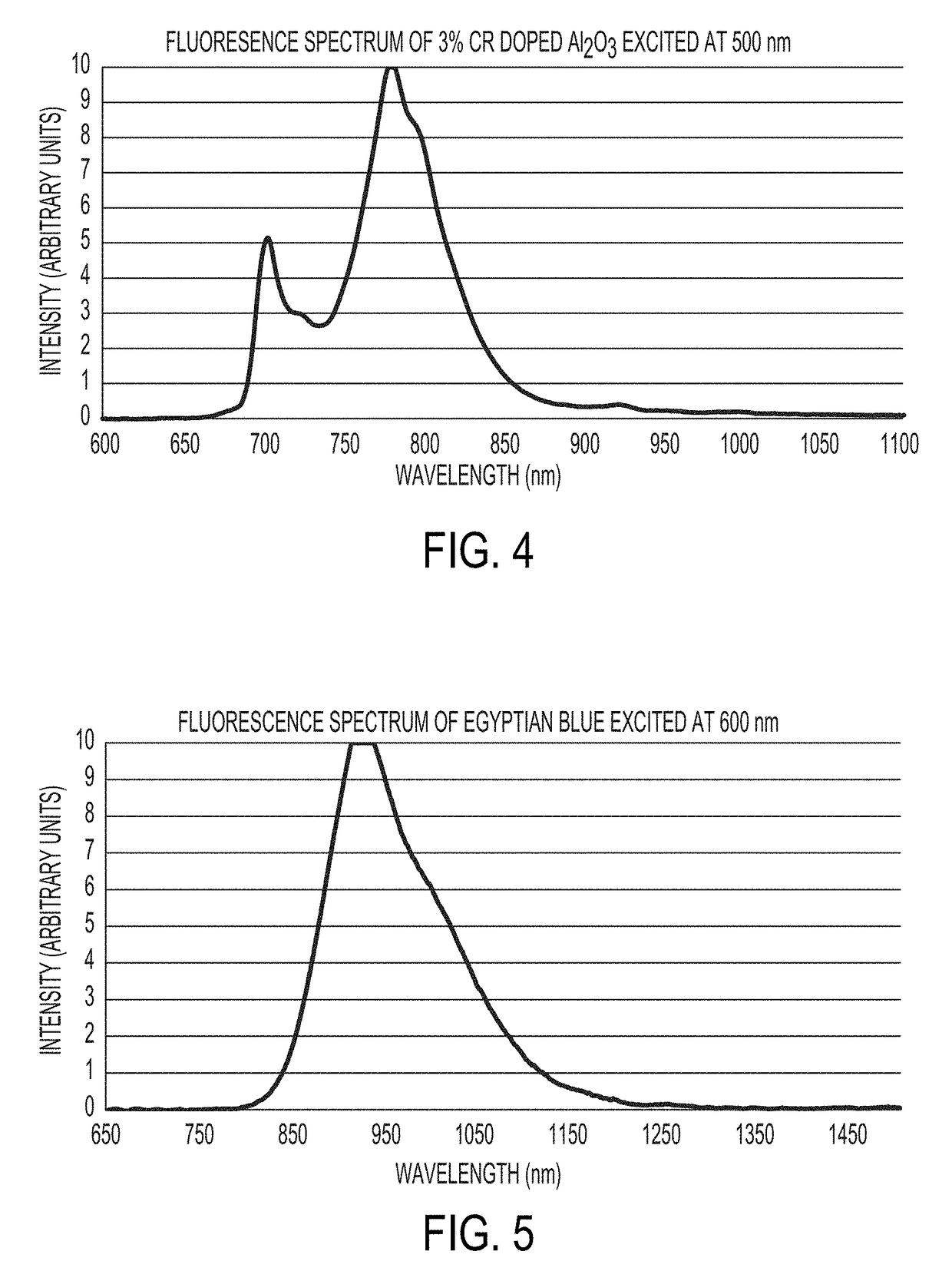Infrared fluorescent coatings
a technology of infrared fluorescent coatings and coatings, applied in the field of cool building materials, can solve the problems of limited infrared reflectance of other specified dark colors, increased temperature, and dark colored building materials, etc., and achieve greater effective solar reflectance (esr), and greater effective solar reflectance (esr).
- Summary
- Abstract
- Description
- Claims
- Application Information
AI Technical Summary
Benefits of technology
Problems solved by technology
Method used
Image
Examples
example 1
Synthesis of Red Pigments via Combustion Synthesis and Analyses
[0140]Samples of Al2O3 (4 g, 16 g, and 200 g) doped with 1 wt % Cr2O3 or 3 wt % of Cr2O3 were synthesized via a combustion synthesis method. Analytical testing was conducted on two samples of dark red pigments Al2O3 doped with 1 wt % Cr2O3 and Al2O3 doped with 3 wt % of Cr2O3. X-ray fluorescence (semi-quantitative) indicated that the elemental compositions of the pigments were close to their expected values. X-ray diffraction XRD patterns of the two samples showed the presence of α-Al2O3, which is the desired phase of Al2O3 for NIR fluorescence. In addition, the narrow peaks in the XRD patterns suggested the presence of large crystalline particles (FIG. 1). Scanning electron microscopy (SEM) was employed to observe the particle size and morphology of the pigment samples prepared by combustion synthesis (FIG. 2, micrograph B). Micrographs indicated the presence of large particles (FIG. 2, micrograph A). During the combust...
example 2
Testing Methods
[0141]Three calibration panels (whose spectral reflectance values were measured using a Perkin Elmer Lamda 900 UV-Vis-NIR spectrometer) were placed onto a support along with an experimental sample. The surface temperatures were measured with an IR thermometer and plotted versus time. The effective solar absorptance for the experimental sample was interpolated from the solar absorptance values for the calibrated samples. The effective solar reflectance (ESR) was then calculated using the formula: ESR=1−effective solar absorptance (a).
[0142]FIG. 3 shows a plot of the temperature rise when all of the standard reference samples are used at the same time. These measurements were taken on a clear summer day, near noon. They show that the sunlit temperature, as a function of spectrometer-measured solar absorptance a, is slightly non-linear. This shows that the basic function of temperature vs. absorptance a has negative curvature.
[0143]Measurement of the fluorescence of the ...
example 3
Coatings Including Red Pigment
[0145]Coatings based on PVDF including 500 g / m2 of Al2O3 doped with Cr2O3 pigments were synthesized via the combustion process described above (particle size of several microns). These coatings had a reflectance of 0.31 at 550 nm. Thinner coatings with 100 g / m2 of Al2O3 doped with Cr2O3 synthesized via the combustion process described above had a reflectance of 0.38 at 550 nm.
[0146]Additionally, Al2O3 doped with 1.5 wt % and 4.5 wt % Cr2O3 pigments with an average particle size of 650 nm were prepared. Egyptian blue pigments were also prepared with an average particle size of 650 nm. These pigments were included into a coating based on a PVDF film-forming resin. Effective solar reflectance (ESR) measurements were made on the coatings made using these pigments and are shown in Table 4. The substrates utilized for the evaluation of the coatings were aluminum substrates coated with a yellow chrome primer.
TABLE 4ESR measurements for samplesSpectrometer(air ...
PUM
| Property | Measurement | Unit |
|---|---|---|
| Temperature | aaaaa | aaaaa |
| Temperature | aaaaa | aaaaa |
| Temperature | aaaaa | aaaaa |
Abstract
Description
Claims
Application Information
 Login to View More
Login to View More - R&D
- Intellectual Property
- Life Sciences
- Materials
- Tech Scout
- Unparalleled Data Quality
- Higher Quality Content
- 60% Fewer Hallucinations
Browse by: Latest US Patents, China's latest patents, Technical Efficacy Thesaurus, Application Domain, Technology Topic, Popular Technical Reports.
© 2025 PatSnap. All rights reserved.Legal|Privacy policy|Modern Slavery Act Transparency Statement|Sitemap|About US| Contact US: help@patsnap.com



